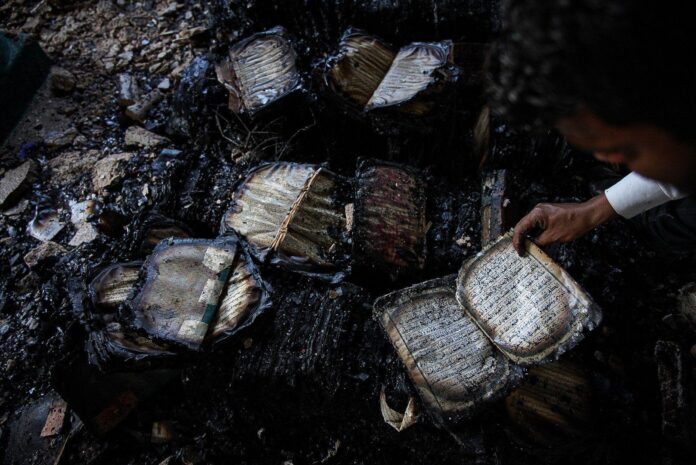On 31 March, the day of a Hindu religious festival and during Ramadan, an extremist mob set a Muslim school, the Azizia Madrasa, and its library ablaze in the city of Bihar Sharif in eastern India. More than 4,500 printed books and manuscripts of Islamic heritage were lost and damaged in the fire. The throng also threw petrol bombs into a nearby mosque and left explosives outside the madrasa’s classrooms. Since the attack, the district’s superintendent of police, Ashok Mishra, has stated that 77 people have been arrested. One person died in the violence, and several remain injured.
Endowed by a woman named Bibi Soghra around a century ago, today the madrasa has 22 classrooms, which serve up to 450 students. Such madrasas form the core of Muslim communities and foster childhood development and education. Now, ashes of burned books line the floors of the school’s library. Images show an imam holding a manuscript with burnt edges and several destroyed handwritten books strewn across the grounds. The histories of these books are forever fragmented.
Anti-Muslim context
This communal violence occurs in the wake of numerous recent laws targeting Muslims on both national and state levels in India. Yet these events have not drawn nearly as much uproar as previous cases, raising concerns as to whether this has become anodyne for the mainstream Indian public and media. Most recently, the National Council of Educational Research and Training (Ncert) dropped entire chapters and sections on Mughal history from Indian school textbooks, effectively erasing three centuries of Indian history from public education and skewing the perspectives of future generations. Leading historians across the world have condemned this, but it is unclear whether that will make any impact.
Bihar has had at least two great sites of learning during its long history. From at least the fifth century AD it witnessed the rise of Nalanda, a Buddhist monastic university, or vihara, from which the region derives its name. The medieval historian Juzjani drew an equivalence between the concept of a vihara and madrasa in his description of Bakhtiyar Khalji’s conquest of Nalanda at the beginning of the 13th century. He noted that the Buddhist site boasted many books and recognised it as a place of deep knowledge, despite its conquest.
Bihar’s capital Patna also houses the Khuda Bakhsh Oriental Public Library, a world-class collection of rare books and manuscripts, especially in Arabic, Persian and Urdu, which opened to the public in 1891. A history of Timur and his successors with 132 full-page paintings commissioned around 1584 stands as one of the library’s finest masterpieces. Yet, in 2021, Bihar’s government proposed to build a flyover that would involve razing a historical part of the library and endangering the safety of the collection. Widespread disapproval halted this plan.
Whether it’s a Buddhist monastery, Muslim madrasa or public manuscript repository, the government of India and international parties must protect heritage whatever its religious affiliation. Unesco has stepped in to protect vulnerable heritage in many other times of crisis globally, and the evidence—from razing Muslim monuments to burning libraries—speaks in favour of intervention. The stewardship of the Endangered Archives Programme and the Hill Museum & Manuscript Library, both supported by the Arcadia Fund, have led the way for digitising collections that could be subject to destruction, neglect or decay, but further institutional and governmental collaboration is necessary for all endangered archives to be documented.
When heritage such as the Azizia Madrasa vanishes, a physical anchor for an entire community ceases to exist within history. Globally, we might even lose the ability to answer questions about the faraway past. For example, a calligraphic practice indigenous to premodern South Asia identified as Bihari apparently acquired this designation because of an association with Bihar. Other reasons for this name have been put forth, but researchers still have no definitive evidence as to why or how this calligraphy came to be popularly known as Bihari. Is the name a modern myth or does it have some historical credence? Given the script’s close relationship to Sufi practices and the long history of Sufism in Bihar, this may have been one reason for the connection. Perhaps the answer lay amid the rubble of the Azizia Madrasa for a student of its community to bring to light. Now, this archive is lost forever.

Qur’an Manuscript, Gwalior, India, 11 July 1399, AKM281 (f.189r-190v)
© The Aga Khan Museum
The burning of a madrasa library finds further resonances within the arguments of contemporary artists who occupy cultural spaces distant from contexts like Bihar Sharif. Shubigi Rao, an artist and the curator of the Kochi-Muziris Bienniale 2022-23, says “the destruction of the Azizia Madrasa [is] heartbreaking, like so many libraries that have suffered similar fates at the hands of those too ignorant and vicious to understand the magnitude and tragedy of such loss.” Rao’s practice has long concerned “libricide” and she made The River of Ink (2008) in response to the destruction of the Bayt al-Hikmah, or the library of Baghdad pillaged during the thirteenth-century Mongol invasions of West Asia. The work features scatters books drowned in ink across crates to evoke ashes and the memory of forgetting.
Meanwhile the centerpiece of Documenta 13, The Parthenon of Forbidden Books by Marta Minujin, featured a symbolic architectural tribute to the many banned books all over the world. In their destruction, such arson of libraries erases knowledge from histories, much like banned or censored books all over the world—such as the case of Mughal history in Indian textbooks.
Far from an isolated event in a provincial town, the burning of the Azizia Madrasa library has global ramifications. It leaves one wondering what the future holds when governments and institutions show no signs of safeguarding Muslim heritage in India. Libraries are not merely stacks of old books. They contain lives whose histories are waiting to be told.
• Vivek Gupta is postdoctoral associate at the University of Cambridge

























